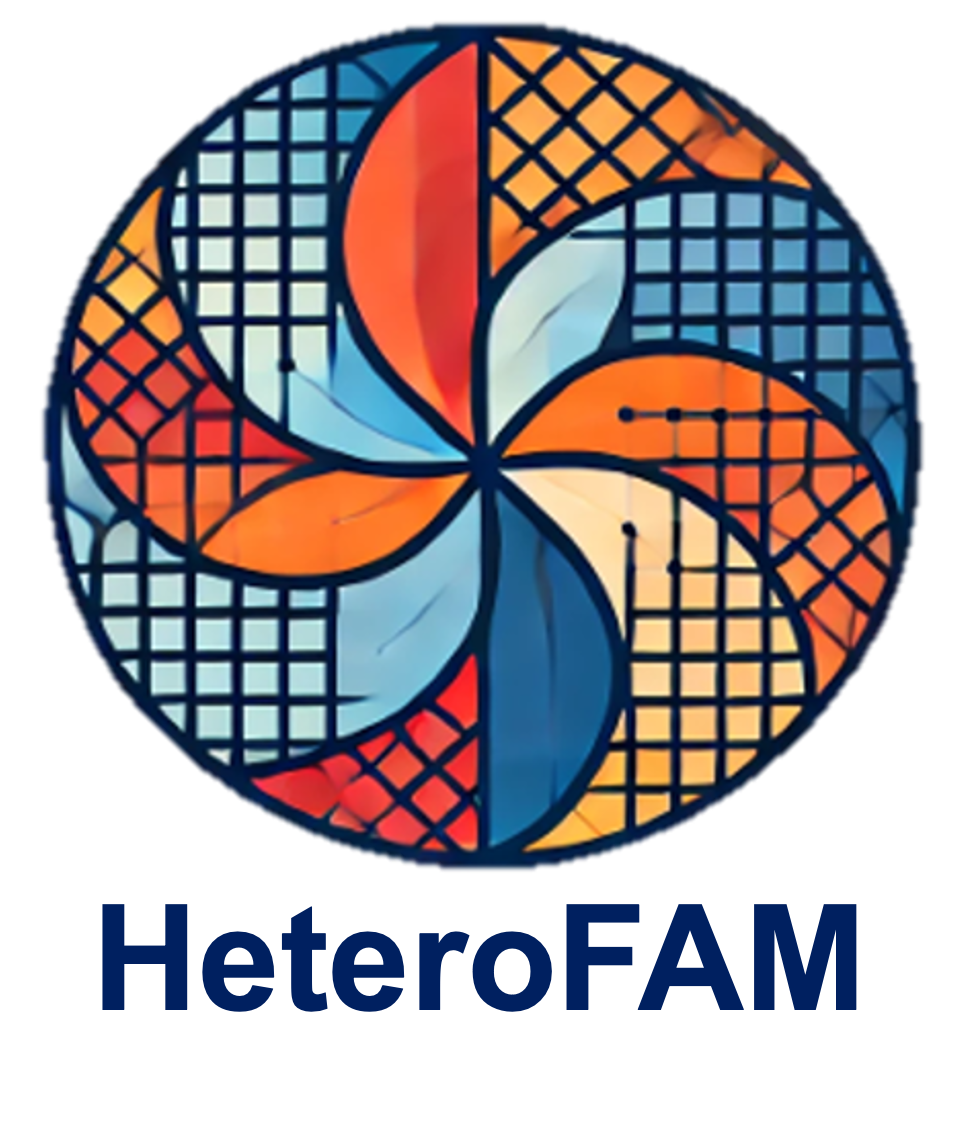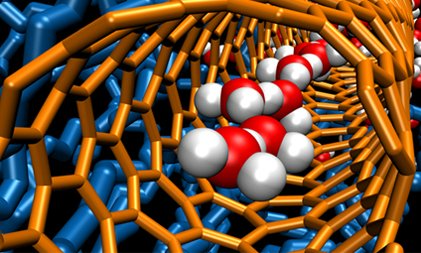 Expert Periodic and Molecular Editor Magnetic Editor SSH Tunneling Manual Projects
Expert Periodic and Molecular Editor Magnetic Editor SSH Tunneling Manual Projects
Navigating the Design Space of Heterostructures
A DOE BES Computational Materials Sciences (CMS) project with the aim of producing widely applicable, validated public-access community codes and associated databases to enable science-based predictive design and discovery of functional materials.
Partner Institutions: Pacific Northwest National Laboratory (PNNL) and the University of Washington (UW)
Sponsor: The U.S. Department of Energy's Basic Energy Sciences Computational Materials Sciences (DOE BES CMS) program.



At the cutting edge of materials research, HeteroFAM is a joint Pacific Northwest National Laboratory (PNNL) and University of Washington (UW) project designed to revolutionize the modeling, discovery, and understanding of complex material systems. By integrating advanced computational tools, machine learning, and automation, HeteroFAM enables breakthroughs in areas such as moiré materials, correlated electron physics and emergent quantum phenomena, and magnetic materials.
Rooted in the three-pillared modeling framework, HeteroFAM bridges first principles, empirical insights, and scalable workflows to tackle the scientific challenges of the 21st century.
The three-pillared modeling framework is the backbone of the HeteroFAM project, combining three core approaches to tackle the most challenging problems in materials science, from moiré materials to quantum systems. These pillars—analytic models, data-driven models, and automation—work together seamlessly to provide a comprehensive and adaptable strategy for discovery.
Rooted in fundamental physical laws, analytic models are the cornerstone of the framework, offering mechanistic insights derived from quantum mechanics, thermodynamics, and classical mechanics. These models provide a deep understanding of the intrinsic behaviors of systems and enable reliable predictions based on first principles.
While analytic models often operate at the fundamental level, they can integrate phenomenological elements to address emergent phenomena and computational challenges across scales, particularly in multi-scale frameworks.
HeteroFAM’s Contributions:
Informed by the philosophy of empiricism, data-driven models utilize machine learning and statistical techniques to extract patterns and relationships from large datasets. These models are indispensable for exploring systems where analytical models may be computationally expensive or difficult to implement.
HeteroFAM’s Contributions:
With the pragmatic goal of enabling scalable, efficient, and reproducible research, automation integrates the analytic and data-driven pillars into dynamic, adaptable workflows. Automation enhances productivity by handling repetitive tasks, optimizing parameters, and seamlessly managing multi-scale simulations.
HeteroFAM’s Contributions:
Together, these three pillars create a robust framework that balances fundamental understanding with practical data applications and scalable automation. This holistic approach enables HeteroFAM to solve some of the most pressing challenges in modern materials science.
HeteroFAM invites collaboration with researchers across disciplines. Whether you’re exploring moiré materials, advancing reaction networks, or tackling quantum magnetism, our platform and expertise are here to support your work.
Moiré materials, formed by stacking and twisting 2D layers with mismatched lattice constants, have emerged as a platform for discovering correlated electron states and topological phases. These systems exhibit highly tunable properties, such as superconductivity, magnetism, and exotic quantum phenomena.
HeteroFAM’s Contributions:
Understanding the physics of strongly correlated electrons is critical for discovering correlated electron states and topological phases and designing materials with unique quantum properties.
HeteroFAM’s Contributions:
Transition metal oxides are key materials for applications in energy, catalysis, and spintronics. Their complex spin configurations present both challenges and opportunities for material design.
HeteroFAM’s Contributions:
HeteroFAM leverages state-of-the-art computational algorithms to enhance the precision and efficiency of its modeling workflows. This includes genetic algorithms, machine learning techniques, and optimization frameworks designed to tackle complex problems in materials science.
Utilizing cutting-edge computational platforms such as quantum computing and exascale computing systems enables HeteroFAM to perform large-scale simulations and handle computationally intensive tasks effectively, driving forward the boundaries of scientific research.
EMSL Arrows acts as the workflow engine behind HeteroFAM, integrating various modeling approaches and facilitating seamless collaboration across different research teams. This web-based platform ensures that complex simulations are accessible and manageable.
| Quarter | Thrust 1: ML Workflows | Thrust 2: COVOs-QFlow | Thrust 3: AI Spin Configurations | Milestones |
|---|---|---|---|---|
| Year 1 | Dataset preparation (Q1-Q2) Initial ML model training (Q3-Q4) |
Define architecture (Q1-Q2) Prototype development (Q3) |
Literature review (Q1-Q2) AI framework design (Q3-Q4) |
Initial prototypes for all thrusts by Q4 |
| Year 2 | Scaling ML models (Q1-Q3) Predict new materials (Q4) |
Advanced functionality (Q1-Q3) Release to the community (Q4) |
Optimizing AI for complex oxides (Q1-Q2) Publish results and tool (Q4) |
Full validation of models and tools by Q4 |
HeteroFAM refers to a project or research initiative focused on the modeling and functional study of heterostructures to explore their advanced functionalities.
Revolutionize materials design and discovery by integrating advanced computational methodologies and machine learning (ML) techniques. Leverage first-principles computational tools, higher-level methods, and advanced AI algorithms tools to enable rational, hypothesis-driven exploration of 2D heterostructures Our platform integrates the latest in computational advancements to provide seamless access to high-performance computing environments.
The mission of the Navigating the Design Space of Heterostructures (HeteroFAM) project is to revolutionize materials science by advancing the computational modeling and design of two-dimensional (2D) materials and transition metal oxides. Leveraging exascale computing, machine learning, and advanced electronic structure methods, the project aims to explore and optimize the properties of complex heterostructures. It focuses on developing tools to enable the rapid discovery of novel materials with enhanced functionalities, with the goal to foster innovation in next-generation technologies. Through community engagement, open software development, and user-friendly interfaces, the project strives to make cutting-edge computational tools accessible to researchers across diverse disciplines, thereby accelerating progress in materials science and engineering.

Sponsored by the U.S. Department of Energy's Basic Energy Sciences Computational Materials Sciences (DOE BES CMCSN) program.
The project is divided into three major thrusts that will progress over two years:
Objective: Develop and test initial machine learning models for predicting the properties of correlated and topological moiré systems.
Objective: Design and build a prototype of COVOs-QFlow for studying correlated electron physics in 2D materials.
Objective: Develop a framework for an AI-driven system to predict spin configurations in transition metal oxides.
Objective: Scale the ML models and workflows to handle more complex 2D materials and moiré systems.
Objective: Enhance the functionality of COVOs-QFlow and integrate advanced features.
Objective: Extend and refine the AI system for larger oxide systems.
| Quarter | Thrust 1: ML Workflows | Thrust 2: COVOs-QFlow | Thrust 3: AI Spin Configurations | Milestones |
|---|---|---|---|---|
| Year 1 | Dataset preparation (Q1-Q2) Initial ML model training (Q3-Q4) |
Define architecture (Q1-Q2) Prototype development (Q3) |
Literature review (Q1-Q2) AI framework design (Q3-Q4) |
Initial prototypes for all thrusts by Q4 |
| Year 2 | Scaling ML models (Q1-Q3) Predict new materials (Q4) |
Advanced functionality (Q1-Q3) Release to the community (Q4) |
Optimizing AI for complex oxides (Q1-Q2) Publish results and tool (Q4) |
Full validation of models and tools by Q4 |
| Software | Description | Link |
|---|---|---|
| NWChemEx PWDFT | NWChemEx is an exascale version of NWChem. It integrates ML techniques and physical simulation workflows to enhance scalability and performance for computational materials design. | NWChemEx PWDFT GitHub Repository |
| Sella | Utility for finding first-order saddle points and minima on potential energy surfaces (PESs). | Sella GitHub Repository |
| COVOS | A tool used in the project, with further details to be provided as development progresses. | Not Available |
| EMSL Arrows | A web application that uses NWChem and chemical computational databases for materials and chemical modeling, supporting free energy methods and surface generation. | EMSL Arrows |
| NWChem | An electronic structure theory package that implements various DFT functionals and enhancements for optimizers and beyond-DFT methods. | NWChem GitHub Repository |
| NWChem GW (Gaussian Method) | Gaussian GW (GW approximation for electronic structure calculations) added to NWChem for accurate electronic properties calculations in molecular systems. | NWChem GW on GitHub |
| Siesta | A density-functional theory (DFT) program used for ab initio molecular simulations of molecules and solids. It will be used in parallel computations to validate machine learning workflows. | Siesta GitHub Repository |
| ExaChem | A tool focused on many-body methods and exascale hybrid MPI-GPU algorithms for computational chemistry. | ExaChem GitHub Repository |
| ExaLearn | A tool that integrates machine learning techniques into computational material science workflows. | Not Available |
This software service and its documentation were developed at the Pacific Northwest National Laboratory, a multiprogram national laboratory, operated for the U.S. Department of Energy by Battelle under Contract Number DE-AC05-76RL01830. Support for this work was provided by the Department of Energy Office of Science, Basic Energy Sciences, Computational Materials Sciences (DOE BES CMCSN) program. THE SOFTWARE SERVICE IS PROVIDED "AS IS", WITHOUT WARRANTY OF ANY KIND, EXPRESS OR IMPLIED, INCLUDING BUT NOT LIMITED TO THE WARRANTIES OF MERCHANTABILITY, FITNESS FOR A PARTICULAR PURPOSE AND NONINFRINGEMENT. IN NO EVENT SHALL THE AUTHORS OR COPYRIGHT HOLDERS BE LIABLE FOR ANY CLAIM, DAMAGES OR OTHER LIABILITY, WHETHER IN AN ACTION OF CONTRACT, TORT OR OTHERWISE, ARISING FROM, OUT OF OR IN CONNECTION WITH THE SOFTWARE SERVICE OR THE USE OR OTHER DEALINGS IN THE SOFTWARE SERVICE.
Keywords: quantum chemistry calculations - quantum chemistry computations - quantum chemistry - molecular modeling calculations - molecular modeling computations - molecular modeling - chemical modeling - chemical reactions calculations - chemical reactions computations - chemical reactions - NWChem calculations - computational chemistry - NWChem